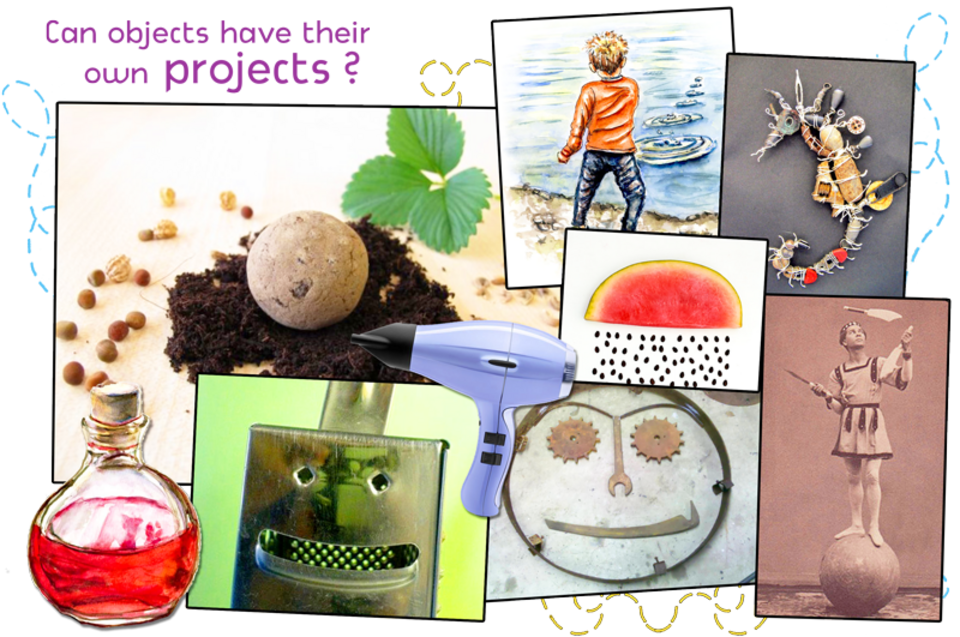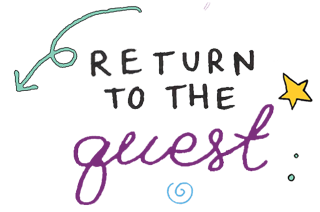
Objects' projects
| Objective: To play with the concept of a project by imagining the craziest projects of your everyday objects! |
Duration: 15 to 45 minutes
Material:
- Sheets of paper
- Pencils, markers, eraser
- An everyday object
Instructions:
What if a pebble’s project was to one day be part of a cathedral? What could motivate this project? What strategies would the pebble think about while sitting by the water? Maybe it harbours the hope that someday a child will pick it up and take it with them... or that they will throw it into the river, leading it to civilization! In this activity, your goal is to imagine an everyday object’s craziest project!
...
- Find your object. Look around your home to find an object that could have big plans if it was a living creature. It could be a complex manufactured object... or something natural. With enough imagination, any object can do the trick!
- Imagine your object’s project. Take a moment to think about the personality of your object: Is it naïvely hopeful or ruthlessly ambitious? Is it optimistic or pessimistic about its chances of accomplishing its project? Then imagine its great project! Is it to do something altruistic or to leave its mark on the world? Is it something it could achieve by staying at home or would it need to travel the world? Is it something it can accomplish on its own, or will it need help from others (or even from you)?
- Inspiration: Here are a few examples of object projects to inspire you: A glass that dreams of being filled with a magic potion; a knife that wants to be used in a circus show; a hair dryer that would like to blow the dead leaves away in the fall; a toy that wishes to be used by ten generations of children in the same family.
- Help your object realize its project. Try to help your object get at least a little closer to realizing its project. To do so, think about the different strategies and resources your object could use. You could clean the object, alter it, introduce it to another object that can assist it... or even take it to a place it has never been before!
- Think about the project. Once you have imagined the project, ask yourself the following questions: What exactly is a project? Should everyone have a project? Does having projects for the future prevent you from enjoying the present? Why or why not?
...
Bonus: Do you know what a "seed bomb" is? It's a small ball of clay and dirt filled with seeds, whose project is to make unlikely places come to life! It simply needs to be thrown in a park or any other suitable place to start sprouting flowers. Amazingly enough, these “bombs” are totally legal and very easy to make... not to mention very good for the Earth! They allow bees to have more places to collect pollen, they preserve biodiversity and they help to consume the carbon emitted by cars. So make your own seed bombs to make your neighbourhood greener! Ingredients:
Preparation:
Finally, think about the following questions: Can a project change the way we look at the world? Can a project change the world? What might it be like to live in a world where projects did not exist? |

| Tricks for tots: The word "project" may be something you hear mostly at school or when adults speak. But all it means is something you want to do in the future, for example, like learning to tie your own shoelaces or winning a football tournament. To help you do this activity, first think about the projects you want to do: Can you think of three things you would like to do in the future? If it helps, you can think about one thing you would like to do tomorrow, one thing you would like to do next week, and one thing you would like to do in several years. Finally, think about these questions: How hard is it to think about the future? Is it important to think about what you want to do in the future? Why or why not? |
| Tips for teens: According to the existentialist philosopher Jean-Paul Sartre, the project is a concept that lies at the heart of human existence. He wrote that, "man is nothing else but his project, he exists only insofar as he realizes himself, he is therefore nothing else but the sum of his actions, nothing else but what his life is." While objects have an "essence" (the essence of a pair of scissors, for example, is to be an object whose purpose is to cut things), humans come into the world without being predestined for any particular purpose: We are basically purposeless, fundamentally nothing. It is only from the moment we begin to act that we can give meaning to our existence. According to Sartre, since we have no essence forcing us to act in a certain way, we have the freedom to choose the projects we want to undertake. But this also means that we have the responsibility to do so: If we refuse to set projects for ourselves and try to accomplish them, it amounts to wanting to exist as an object rather than as a free being, which Sartre deems cowardly. What do you think about these ideas? Is it true that humans come into the world as "nothing," that is, without any particular essence or purpose? Are we truly free to choose the projects we want for ourselves, or are there things that constrain our choices? Is it necessarily cowardly to refuse to choose what to do in a given situation? Why or why not? |
Share your creative reflections by sending them via email.
Include photos of your projects and notes of your thoughts, as well as your first name and your age!


